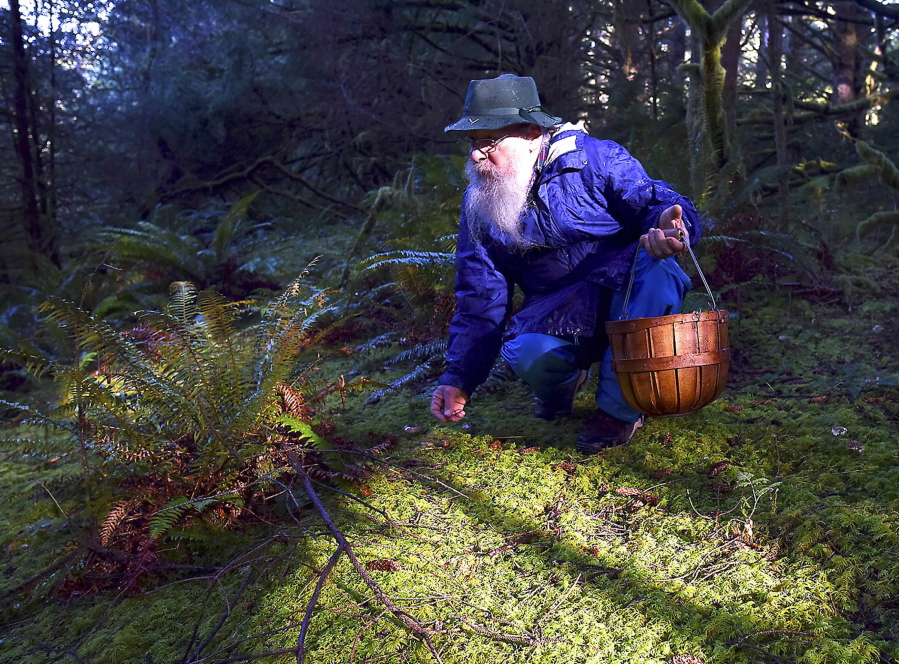ASTORIA, Ore. — When they heard the whistle, the mushroom hunters were ready.
Carolyn Tesar and Mike Holland-Moritz whistled a reply and pushed deeper into the woods, following their ears until they reached their companion, Stephen Walsh, and a clump of mushrooms he’d just discovered.
The three Portland residents, all members of the Oregon Mycological Society, spent a weekday morning together looking for mushrooms in the woods around Fort Stevens State Park. While Walsh ranged farther ahead, scanning for signs of fungi, the others followed at a more leisurely pace, exploring patches thoroughly before hitting the next bit of promising ground.
The promise of edible fungi pulls thousands of people into Oregon’s forests in the spring and fall. On the coast, mushroom season typically arrives in full force by October, with cascades of golden chanterelle mushrooms that spike the air with their earthy, apricot scent and king boletes that suddenly dot the forest floor.
Carla Cole, natural resources project manager at the Lewis and Clark National Historical Park near Warrenton, understands the appeal and excitement of hunting for edible mushrooms. But, mushrooms aren’t just about what’s visible above ground, she said.
“The Pacific Northwest ecosystems have such a huge, rich fungal diversity,” she said. “There’s so much going on underground, in the soil.”
Hunters and hunted
Mushroom caps gleam with slime, explode in overlapping sprays on the sides of fallen trees, peek out between tree roots or under pine needles. Fort Stevens State Park Ranger Dane Osis, who leads regular wild mushroom hikes through the park, has called the Oregon Coast one of the best places to hunt for mushrooms, especially for edible varieties.
Even if you return from a hunt empty-handed, seasoned North Coast mushroom hunters will say the worst thing that happened is you spent some time in the woods.
Interest in edible mushroom hunting has remained strong over the years, if not grown in popularity. Still, one of the North Coast’s most visually stunning mushrooms is not for eating.
When fall turns the element-battered woods around Fort Stevens gray and brown and even the ferns have lost their shine, the fly amanita rises from the forest floor. It is a mushroom straight from the pages of “Alice in Wonderland,” the fungi you find mixed among poodles and flowers in your smartphone’s emoji options. With its brilliant red and orange cap and scattered white warts, it is the mushroom of popular culture. Troops of it march across the forest floor at Fort Stevens each fall; they can have unpredictable toxic, and possibly dangerous, effects if eaten, notes mycologist David Aurora in his guide to Western mushrooms “All That the Rain Promises and More.”
In past years, however, people have come to Fort Stevens not to gape at the fly amanita, but to hunt for an unremarkable looking little mushroom with hallucinogenic powers. These mushrooms are considered a controlled substance, illegal to harvest or possess. Oregon State Police troopers and Clatsop County law enforcement once patrolled Fort Stevens State Park regularly this time of year. Across the Columbia River, rangers at Washington state’s Cape Disappointment State Park have had to keep an eye out for people looking for similar varieties there as well.
Oregon State Police Lt. Andrew Merila recently noted a decrease in the number of cases coming across his desk, but said this could be because he is not able to run as many patrols around Fort Stevens as in the past.
Fungi buddies
The above-ground parts of the mushroom — the prized “fruiting bodies” — people pick to eat for dinner, use to get high or simply appreciate for their strangeness and beauty only tell one side of the story, Cole said. Underground, the forest is a world of “infinite biological pathways,” as ecologist Suzanne Simard said in a talk last summer — and mushrooms have a big role to play.
In recent years, Simard’s work has contributed to a growing understanding of how forest ecosystems function, revealing that the below-ground part of the mushroom that digests nutrients and produces the above-ground fruiting bodies, the mycelium, often works in partnership with trees. The mycelium functions as an extension of the trees’ root systems.
In his book “Mycelium Running,” mycologist Paul Stamets writes that mycelium is tiny enough that “one cubic inch of soil can contain enough to stretch for 8 miles.”
“They’re so small that it allows the trees access to way more water and soil nutrients than they’d be able to get on their own,” Cole said. In return, the trees supply the fungi with food.
The partnership has big implications for forest health. In addition to being able to bring more to their tree buddies, the fungi functions as a sort of communications system between trees. Using mycelium, a healthy tree can send nutrients to a stressed tree an acre or two away, Cole said.
“This becomes extremely important in times of stress or drought or in timber practices like clear-cuts,” she said. “(This network) allows trees to survive through harsh conditions that the tree, on its own, wouldn’t be able to survive.”
Mycelium can live for a few days or several hundred years, depending on where it’s based and what it’s growing in. Adaptable and quick to evolve, fungi can respond swiftly to changes in the ecosystem. Trees exist on a very different time scale than fungi and may not be able to react quickly to disease or stress, but, said Cole, “Their fungal partners can.”



